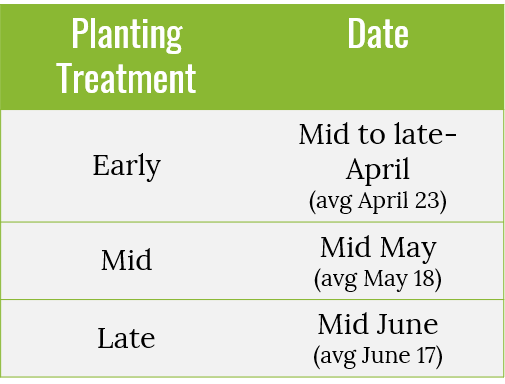Soybean producers and consultants have been trying to push the yield limits on modern, high-yielding soybean varieties in recent years. One means of improving yields is by being strategic about planting timing and maturity group selection, which play a major role in achieving maximum yield potential in a given year. Weather is ultimately the driving factor for deciding when field activities take place in North Carolina, making it nearly impossible for growers to stick to a strict planting and management calendar.
However, the more we understand the relationship between maturity group, planting date, and weather patterns, the more likely we are to attain our goal of improving yield. The NC Soybean Producers has funded a multi-year study to further understand the influence of planting date and maturity group selection in conjunction with a group of crop consultants across Eastern NC.
This work was carried out over the last two years across 5 locations in the eastern part of the stae. Two in the Tidewater region (Perquimans and Beaufort) and three in the Coastal Plain region (Northampton, Pitt, and Robeson).
In 2017, favorable weather in April and a rapid accumulation of heat units favored soybean planting in Mid-April, with the optimal maturity being in the 4.8 to 5.2 relative maturity (RM) range. The 2017 study included eight varieties ranging from RM 4.8 to 5.9 evaluated across five locations in NC. In 2018, the number of varieties and maturity groups were expanded to capture the extreme limits of soybean maturity typically grown in NC. 2018 included varieties from RM 3.2 to 6.
Three planting were tested included an early planting (mid-April), a mid planting (mid-May), and a late planting (mid-June) .

The response of soybeans to planting date was very different from location to location. We averaged data from 2017 and 2018 to give a more complete picture of what is “typical” of each of the locations evaluated.
In Perquimans, Mid-April and Mid-May planted soybeans in the RM range of Late III to Late IV were on average 13 bu/A better on average compared with Mid-June planted beans. However, the benefit of early planting in Perquimans was minimal or a non-factor when later maturing varieties were planted. The highest yielding scenario in Perquimans was an Early IV planted in Mid-April and May.
In Beaufort, highest yields were achieved when soybeans of the Late III, Early IV, Late IV RM groups were planted in May. On average, these early varieties planted in mid-May out yielded mid-April beans by almost 14 bu/A and mid-June planted beans by nearly 29 bu/A. Several late planted plots were lost due in 2018 to bad weather making it difficult to analyze the full impact of the interaction.
In Pitt, the opposite trend was observed compared with the Blackland locations. At this location, early maturing varieties (Late III to Late IV) performed better as planting date was later in the season and later maturing varieties performed better when planted earlier in the season. Optimal yields were achieved when Group IV’s were planted in June and when Group V’s were planting in April or May.
In Robeson County, in most cases, planting in mid-May and mid-June was better than planting in mid-April across all maturities. The “sweet spot” for Robeson was a mid-May planting timing and a Early V soybean. Similar to Pitt, early maturing varieties seemed to do better when planted later.
In Northampton County, Late V’s and Mid-Late VI’s performed best overall compared to all other maturity groups. Group V and VI beans out yielded group III and IV beans by nearly 15 bushels on average and highest yields were achieved by planting a Mid-Late Group VI soybean in mid-April.
Weather played a major role in the outcome of this study in 2018. Heavy rains in the early fall from Hurricane Florence hurt yields of early planted and/or early maturing soybeans, particularly in Robeson, Pitt, and Northampton counties. Less than ideal growing conditions in April were not conducive to producing the high yields that were seen with early maturing varieties in the Tidewater region in 2017. Abnormally high rainfall in June hurt stands of late planted beans in Beaufort causing some bean plots to be abandoned.
This two-year study suggests that over all locations and environments the ideal combination is a Late IV or Early V planted from Mid-April to Mid-May. While most seasons have a “sweet spot” with the most potential for outstanding yields, finding it can be a difficult proposition unless you spread your risk as a producer.
For instance, averaged across all locations, the cost of making the wrong decision in variety and planting date could have been as much as 35 bu/A. Of course there is no way to predict the weather but this research shows how critical it is to manage risk by paying attention to weather forecasts at planting time, multi-year/multi-location variety trial data when selecting varieties, and planting multiple varieties of varying maturities in order to avoid significant weather events.













